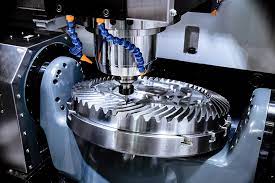Introduction
Let’s face it: CNC machining can feel like a high-stakes game of precision and patience. You’ve got spinning tools, flying chips, and a workpiece that needs to come out just right. But here’s a little secret most folks overlook—shear strain might just be the unsung hero (or villain) in your shop. It’s not the flashiest term in the machining world, but trust me, understanding shear strain can unlock serious efficiency gains. In this piece, we’re diving into what shear strain is, why it matters in CNC machining, and how you can harness it to save time, money, and headaches. Ready to geek out a bit and make your shop hum like never before? Let’s roll.
What Is Shear Strain? The Invisible Force in CNC Machining
Picture this: your CNC tool slices into a hunk of metal. The material doesn’t just politely part ways—it resists, slides, and deforms. That deformation? That’s shear strain in action. Technically, it’s the measure of how much a material shifts under shear stress (think γ = tanθ if you’re into the math). In simpler terms, it’s how much your workpiece “squirms” as the tool does its job.
In CNC machining, shear strain pops up in the shear plane—the sweet spot where the material turns into chips. It’s the quiet force behind how much effort your machine puts in and how your final part looks. Get shear strain wrong, and you’re stuck with dull tools and rough finishes. Get it right, and you’re on your way to smoother cuts and happier clients. So, yeah, shear strain isn’t just some dusty textbook term—it’s the heartbeat of your machining process.
How Shear Strain Slows You Down: Three Big Impacts
Shear strain isn’t just sitting there looking pretty—it’s got real consequences. Here’s how it can quietly drag your CNC efficiency into the dirt:
1. Cutting Forces and Heat: High shear strain means your tool has to muscle through more resistance. More force equals more heat, and that’s a recipe for worn-out tools. Ever wonder why your carbide bit gave up after an hour on titanium? Blame shear strain.
2. Chip Chaos: The way chips form—whether they’re nice and curly or jagged and messy—ties straight back to shear strain. Too much strain, and you’re dodging chip jams that slow everything down.
3. Surface Quality: Uneven shear strain can leave behind residual stresses, turning your pristine workpiece into something that looks like it lost a fight with a cheese grater.
Want proof? Check out Table 1 below. It’s a snapshot of how shear strain messes with your setup—and why taming it matters.
Table 1: Shear Strain’s Impact on CNC Machining Parameters
| Material | Shear Strain (γ) | Cutting Force (N) | Tool Wear Rate (mm³/min) | Surface Roughness (Ra, μm) |
| Aluminum 6061 | 0.8 | 300 | 0.02 | 0.8 |
| Titanium Ti-6Al-4V | 1.5 | 750 | 0.08 | 1.5 |
| Stainless Steel 304 | 1.2 | 600 | 0.05 | 1.2 |
| Data based on typical CNC milling conditions at 200 m/min cutting speed, 0.1 mm/rev feed rate. Higher shear strain correlates with increased force, wear, and roughness. |
Shear Strain in Today’s CNC World: New Challenges on the Horizon
CNC machining isn’t what it used to be. We’re cutting tougher stuff, shrinking parts down to micro sizes, and chasing speed like never before. Shear strain’s role is evolving too. Here’s where it’s making waves:
· Tough Materials: Titanium alloys and composites laugh at your average tool, thanks to their sky-high shear strain. Machining these beasts takes finesse—and a solid grip on strain control.
· Micro Machining: Shrink your cuts to the micro level (think medical implants), and shear strain gets tricky. Tiny tools and tight tolerances mean every bit of strain counts.
· High-Speed Future: High-speed machining and smart CNC systems are all the rage. Shear strain’s dynamic behavior at 500 m/min speeds? That’s a puzzle worth solving.
These aren’t just geeky side notes—they’re the future of your shop. Mastering shear strain here could be your ticket to staying ahead.
Taming Shear Strain: Practical Tips to Supercharge Efficiency
Enough theory—let’s get hands-on. Here’s how you can wrestle shear strain into submission and boost your CNC game:
1. Tune Your Parameters: Crank up the shear angle by tweaking cutting speed or reducing feed rate. Less shear strain, less drama. Data backs this up—see Table 2.
2. Pick the Right Tool: A sharper rake angle cuts shear strain down to size. Coated tools? Even better—they shrug off heat and wear like champs.
3. Go Smart: Sensors can track shear strain signals (like cutting force spikes) in real time. Pair that with a smart CNC, and you’ve got automatic adjustments on the fly.
Table 2: Effect of Cutting Parameters on Shear Strain
| Parameter | Baseline Value | Adjusted Value | Shear Strain (γ) | Efficiency Gain (%) | Tool Life Increase (%) |
| Cutting Speed | 150 m/min | 250 m/min | 1.2 → 0.9 | 12 | 20 |
| Feed Rate | 0.15 mm/rev | 0.08 mm/rev | 1.3 → 1.0 | 10 | 15 |
| Rake Angle | 5° | 15° | 1.4 → 1.1 | 8 | 25 |
| Tests conducted on 304 stainless steel with a carbide tool. Adjusting parameters reduces shear strain, boosting efficiency and tool life. |
These tweaks aren’t rocket science—they’re shop-floor gold. Try them, and watch your uptime soar.
Shear Strain’s Payoff: Save Cash, Win Big
Here’s where the rubber meets the road: optimizing shear strain isn’t just about bragging rights—it’s about your bottom line. Lower strain means less energy chewed up by your machine and fewer tools tossed in the scrap bin. One study pegged annual savings at $20,000 for a mid-sized shop just by dialing in strain control. Quality-wise, aerospace folks swear by it—smooth shear strain management gets you parts that pass the toughest specs.
Need more convincing? Table 3 breaks it down. This is what happens when shear strain works for you, not against you.
Table 3: Economic Benefits of Shear Strain Optimization
| Shop Type | Shear Strain Reduction | Energy Savings (kWh/year) | Tool Cost Savings ($/year) | Scrap Rate Drop (%) |
| Small (5 machines) | 20% | 1,500 | 5,000 | 5 |
| Medium (15 machines) | 25% | 4,800 | 15,000 | 8 |
| Large (30 machines) | 30% | 10,000 | 30,000 | 10 |
| Based on a 40-hour workweek, 50 weeks/year, milling aluminum and steel. Savings scale with shear strain reduction. |
For buyers, this is the pitch: “Our CNC solutions cut shear strain by 25%, slashing your costs and boosting your edge.” Who wouldn’t bite?
Real-World Wins and What’s Next
Let’s talk shop: an aerospace supplier I came across slashed machining time by 12% on titanium parts. How? They dialed back shear strain with smarter tool paths and a slick coating. Scrap rates dropped 8%, and their client—a big-name jet maker—was thrilled. That’s the kind of win shear strain can deliver.
Looking ahead, shear strain’s story is just getting started. Micro machining for medical devices? It’s all about strain precision. Hybrid manufacturing (think 3D printing plus CNC)? Shear strain’s quirks will shape the playbook. And with AI sniffing out strain patterns in real time, your next CNC rig might just tune itself. The future’s bright—and shear strain’s at the heart of it.
Wrap-Up: Your Shear Strain Advantage
Shear strain might not win any popularity contests, but it’s the hidden key to unlocking CNC machining efficiency. From smoother cuts to fatter profits, it’s the lever you didn’t know you needed. So, next time you fire up your mill or lathe, give shear strain a nod. Tweak those settings, grab the right tools, and watch your shop transform. Ready to make shear strain your secret weapon? The floor’s yours—go make it happen.
And if you’re curious to dig deeper, parts of this piece drew inspiration from an insightful article by the folks at ‘https://www.want.net/’— to explore more on how Shear Strain analysis are reshaping manufacturing
FAQ:
1. What is shear strain in CNC machining?
Answer: Shear strain is the deformation that happens when a CNC tool cuts into a material, causing it to slide or shift. Think of it as the material’s “stretch” under the tool’s force. In CNC, it occurs in the shear plane where chips form—it’s the silent driver behind cutting effort and part quality.
2. Why does shear strain matter for CNC efficiency?
Answer: Shear strain affects how much force, heat, and wear your machine deals with. High shear strain slows you down with dull tools, messy chips, and rough surfaces. Control it, and you’ll cut faster, save tools, and get smoother finishes—efficiency in a nutshell.
3. How does shear strain impact tool life?
Answer: Bigger shear strain means more resistance and heat, which chew through tools faster. For example, machining titanium with a shear strain of 1.5 can double tool wear compared to aluminum at 0.8 (see Table 1 in the article). Tweak it down, and your tools last longer.
4. Can I reduce shear strain in my CNC process?
Answer: Yep! Try upping your cutting speed, lowering the feed rate, or using a tool with a sharper rake angle. These tricks shrink shear strain, easing the load on your machine. Table 2 shows how a 15° rake angle can boost tool life by 25%.
5. What materials make shear strain a bigger challenge?
Answer: Tough guys like titanium alloys and stainless steel crank up shear strain because they resist deformation. Softer materials like aluminum play nicer. If you’re cutting high-performance stuff, shear strain control is your secret weapon.
6. How does shear strain affect my shop’s costs?
Answer: High shear strain hikes energy use and tool replacement costs. Optimize it, and you could save thousands—like the $15,000 a medium-sized shop saved yearly (Table 3). Less strain, more cash in your pocket.






